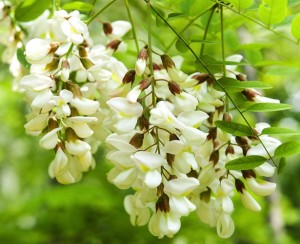
Not long ago I was on a road trip just as the mid-spring flowering trees were bursting into bloom. Cascades of white, wisteria-like blooms billowed from many of the trees along highways in central New York State. They stood out, even as we whizzed by at highway speed. Every once in awhile, a pink-flowered tree with similar blossoms popped up.
What were those magical trees?
When I see flowers that look like wisteria, I automatically think of members of the legume family. Old-fashioned taxonomists call this family Leguminosae and modern ones call it Fabaceae. Whatever you call it, the legume family is full of beautiful, essential plants, including species from garden peas to peanuts. You can eat the fruits of legumes or feed them to animals. The flowers of some species produce nectar that bees turn into very tasty honey and the roots fix nitrogen in the soil, which is essential for fertility. If you have ever seen a garden pea plant in flower, you will have a good idea of what many legume flowers look like. Wisteria, for example, features drooping flower bunches composed of scores of pea-like blossoms.
Though hard to see from the highway, the gorgeous trees had compound leaves—groups of small leaflets arrayed in clusters on the branches. Those leaves, plus the distinctive flowers marked the trees as locusts, which are members of the legume family. The looks of the leaves, plus flowers, stature and other attributes confirmed the trees’ identity. They are Robinia pseudoacacia, sometimes also known as black locust or false acacia. While quite common in some areas, they are thoroughly uncommon when it comes to beauty.
Robinia is native to southeastern North America, and was one of the first North American natives taken to Europe by early explorers. Linnaeus named it after gardener and herbalist Jean Robin, who served King Henri IV of France. According to Martin Rix in The Botanical Garden, a Robinia, planted in the seventeenth century, survived in the Jardin des Plantes botanical garden in Paris until sometime in the 1980’s. A Robinia planted in 1759 still stands in England’s Kew Gardens.
The “pseudoacacia” part of the Latin name–which gave rise to the common name “false acacia”–refers to the leaves, which resemble those of its relative, the acacia tree.
So how do you recognize a robinia? The trees can be as tall as eighty feet, with furrowed bark. The leaves are very small and pinnate or feather-like, arranged in odd-numbered groups of five to nineteen on opposite sides of the stems. The fragrant, wisteria-like flowers are pendulous, appearing in mid to late spring. The most common Robinia pseudoacacia cultivars generally have white flowers, but some species sport pink ones. One variety, Robinia ‘Purple Robe’, has dark pink blossoms and, according to one catalogue, purplish new foliage that turns green as it ages. The flowers are succeeded by flat, brown, bean-like seed pods.
Robinia has many virtues including beauty, hardiness and fast growth rate, which is why it is sometimes planted as a street or roadside tree. It is also tolerant of pollution and poor soil. The blossoms attract pollinating insects, especially bees, making it valuable for urban and suburban ecosystems. With hard, rot-resistant wood, black locust is also useful for things like fence posts that have to survive outside. When properly dried it also makes great firewood.
With all those virtues, you would think that there would be a robinia on every street corner from southern New York State south. However, like many good things, including chocolate and fast cars, robinia has liabilities. It suckers and self seeds readily in many places, so vigilance on the part of the gardener is in order. Suckers can be easily removed with loppers and the seedlings can be pulled, hoed or mowed down. I have to confess that I don’t get as excited about seedlings as many people, probably because I have a lovely maple tree in front of my house that produces hundreds, if not thousands of seedlings a year. They can be a pain in the neck, and occasionally, the lower back, but nothing more, and I wouldn’t think of removing a magnificent tree because of them.
In some places, black locusts are also vulnerable to locust borers, which bore into the bark, allowing pathogens to infiltrate the trees. A call to your county extension agent will help you determine whether or not locust borers are common in your area.
The best solution for any pest problem is to avoid a monoculture where a single genus or species predominates. Planting robinia on your property–if you have the room–will add variety to the standard oaks and maples, give you great flowers in the spring and make the all-important neighborhood bees very, very happy.
For a good selection of robinia species and cultivars, try ForestFarm, PO Box 1, 14643 Watergap Road, Williams, OR 97544; (541) 846-7269 or www.forestfarm.com.
